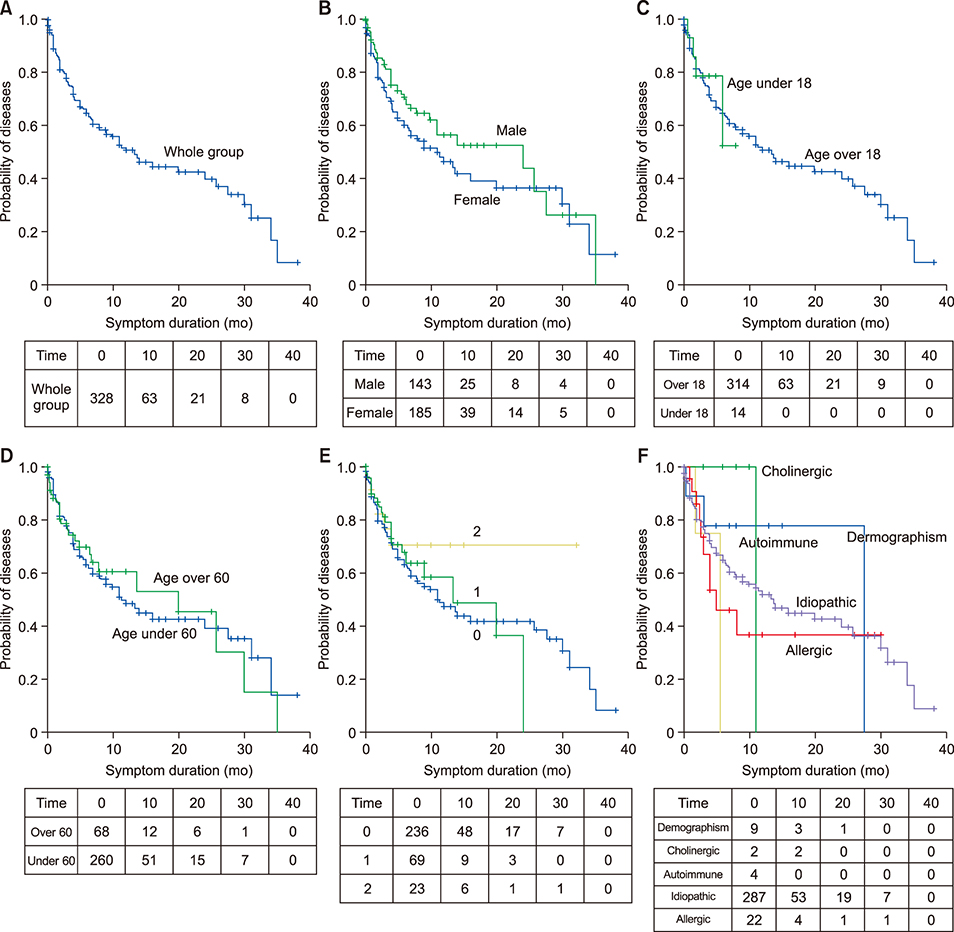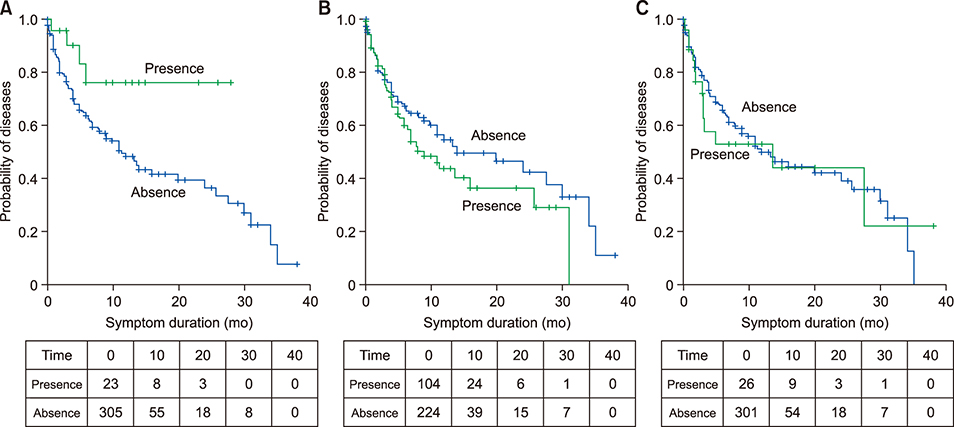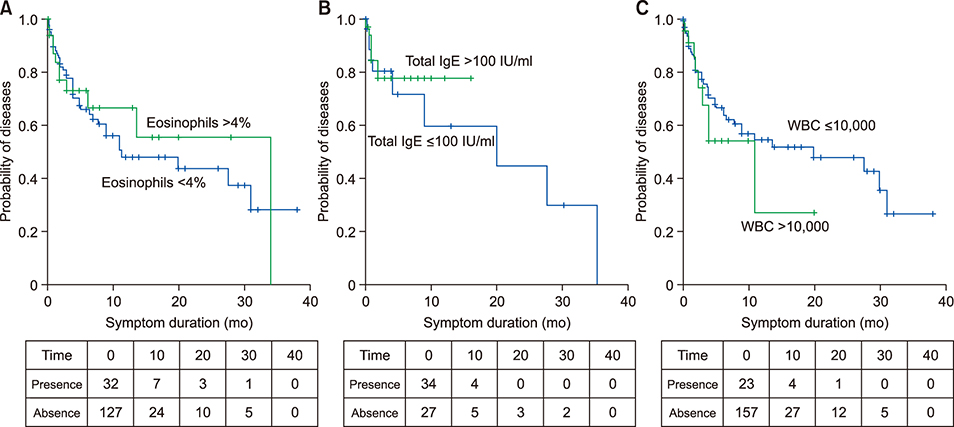Ann Dermatol.
2020 Feb;32(1):38-46. 10.5021/ad.2020.32.1.38.
Natural History of Chronic Urticaria in Korea
- Affiliations
-
- 1Department of Dermatology, College of Medicine, Hallym University, Seoul, Korea. dermap@hanmail.net, hyeonekim@gmail.com
- KMID: 2467199
- DOI: http://doi.org/10.5021/ad.2020.32.1.38
Abstract
- BACKGROUND
Data on the natural history and prognostic variables of chronic urticaria (CU) are rare and information about spontaneous remission of CU is limited.
OBJECTIVE
This study evaluated the natural history of CU and identified predictors for remission.
METHODS
Total 329 Korean patients with CU, who had follow-ups more than 6 months after diagnosis during a 7-year period in the department of dermatology in three university hospitals were enrolled. Clinical data and laboratory findings obtained by medical records and telephone interviews were analyzed, retrospectively.
RESULTS
The proportion recovered in 1, 3, and 5 years after the onset of CU was 10.8%, 18.8%, and 32.9%, respectively. The mean duration of CU was 6.3 years. There were no significant differences in median recovery time depending on sex, age group, severity of CU, and type of CU. The presence of angioedema was significantly related to CU severity. There were no differences in prognosis with respect to the presence of dermographism or angioedema. Patients with atopic dermatitis (AD) had a significantly worse prognosis than patients without a history of AD; but not in patients with the history of allergic rhinitis or asthma. Patients with abnormal laboratory findings did not differ significantly in prognosis.
CONCLUSION
CU remission rate significantly differ according to the presence of AD. This study provides information about the natural course of CU of Korean patients.
Keyword
MeSH Terms
Figure
Reference
-
1. Sahiner UM, Civelek E, Tuncer A, Yavuz ST, Karabulut E, Sackesen C, et al. Chronic urticaria: etiology and natural course in children. Int Arch Allergy Immunol. 2011; 156:224–230.
Article2. van der Valk PG, Moret G, Kiemeney LA. The natural history of chronic urticaria and angioedema in patients visiting a tertiary referral centre. Br J Dermatol. 2002; 146:110–113.
Article3. Kang HS, Shin MY. Clinical aspects of chronic urticaria in children. Korean J Pediatr. 2009; 52:205–212.
Article4. Ban GY, Kim MY, Yoo HS, Nahm DH, Ye YM, Shin YS, et al. Clinical features of elderly chronic urticaria. Korean J Intern Med. 2014; 29:800–806.
Article5. Toubi E, Kessel A, Avshovich N, Bamberger E, Sabo E, Nusem D, et al. Clinical and laboratory parameters in predicting chronic urticaria duration: a prospective study of 139 patients. Allergy. 2004; 59:869–873.
Article6. Najib U, Bajwa ZH, Ostro MG, Sheikh J. A retrospective review of clinical presentation, thyroid autoimmunity, laboratory characteristics, and therapies used in patients with chronic idiopathic urticaria. Ann Allergy Asthma Immunol. 2009; 103:496–501.
Article7. Najib U, Sheikh J. The spectrum of chronic urticaria. Allergy Asthma Proc. 2009; 30:1–10.
Article8. Lee EA, Kim HS, Lee JY, Kim HO, Park YM. Analysis of the effect of oral antihistamines in patients with chronic urticaria in terms of the disease outcome and quality of life. Korean J Dermatol. 2010; 48:758–765.9. Kozel MM, Mekkes JR, Bossuyt PM, Bos JD. Natural course of physical and chronic urticaria and angioedema in 220 patients. J Am Acad Dermatol. 2001; 45:387–391.
Article10. Lee SY, Song WJ, Jung JW, Park HW, Cho SH, Min KU, et al. Thyroid autoantibodies and the prognosis of chronic idiopathic urticaria. Allergy Asthma Respir Dis. 2013; 1:151–156.
Article11. Komarow HD, Arceo S, Young M, Nelson C, Metcalfe DD. Dissociation between history and challenge in patients with physical urticaria. J Allergy Clin Immunol Pract. 2014; 2:786–790.
Article12. Schoepke N, Doumoulakis G, Maurer M. Diagnosis of urticaria. Indian J Dermatol. 2013; 58:211–218.
Article13. Sánchez J, Sánchez A, Cardona R. Causal relationship between Anti-TPO IgE and chronic urticaria by in vitro and in vivo tests. Allergy Asthma Immunol Res. 2019; 11:29–42.
Article14. Greaves M. Chronic urticaria. J Allergy Clin Immunol. 2000; 105:664–672.
Article15. Frank MM. 8. Hereditary angioedema. J Allergy Clin Immunol. 2008; 121:S398–S401.
Article16. Humphreys F, Hunter JA. The characteristics of urticaria in 390 patients. Br J Dermatol. 1998; 138:635–638.
Article17. Quaranta JH, Rohr AS, Rachelefsky GS, Siegel SC, Katz RM, Spector SL, et al. The natural history and response to therapy of chronic urticaria and angioedema. Ann Allergy. 1989; 62:421–424.18. Juhlin L. Recurrent urticaria: clinical investigation of 330 patients. Br J Dermatol. 1981; 104:369–381.
Article19. Ye YM, Kim BE, Shin YS, Park HS, Leung DYM. Increased epidermal filaggrin in chronic idiopathic urticaria is associated with severity of urticaria. Ann Allergy Asthma Immunol. 2014; 112:533–538.
Article20. Champion RH, Roberts SO, Carpenter RG, Roger JH. Urticaria and angio-oedema. A review of 554 patients. Br J Dermatol. 1969; 81:588–597.21. Kulthanan K, Jiamton S, Thumpimukvatana N, Pinkaew S. Chronic idiopathic urticaria: prevalence and clinical course. J Dermatol. 2007; 34:294–301.
Article22. Kim S, Baek S, Shin B, Yoon SY, Park SY, Lee T, et al. Influence of initial treatment modality on long-term control of chronic idiopathic urticaria. PLoS One. 2013; 8:e69345.
Article23. Park HH, Lee JY, Song AR, Jung MY, Kim MJ, Sohn IS, et al. Natural course and prognostic factors of chronic urticaria in Korean children: a single center experience. Asian Pac J Allergy Immunol. 2019; 37:19–24.
Article24. Olze H, Zuberbier T. Comorbidities between nose and skin allergy. Curr Opin Allergy Clin Immunol. 2011; 11:457–463.
Article25. Darlenski R, Kazandjieva J, Zuberbier T, Tsankov N. Chronic urticaria as a systemic disease. Clin Dermatol. 2014; 32:420–423.
Article26. Ye YM, Jin HJ, Hwang EK, Nam YH, Kim JH, Shin YS, et al. Co-existence of chronic urticaria and metabolic syndrome: clinical implications. Acta Derm Venereol. 2013; 93:156–160.
Article27. Böhme M, Lannero E, Wickman M, Nordvall SL, Wahlgren CF. Atopic dermatitis and concomitant disease patterns in children up to two years of age. Acta Derm Venereol. 2002; 82:98–103.
Article28. Magen E, Mishal J, Schlesinger M. Clinical and laboratory features of chronic idiopathic urticaria in the elderly. Int J Dermatol. 2013; 52:1387–1391.
Article29. Champion RH. Urticaria: then and now. Br J Dermatol. 1988; 119:427–436.
Article30. Kozel MM, Bossuyt PM, Mekkes JR, Bos JD. Laboratory tests and identified diagnoses in patients with physical and chronic urticaria and angioedema: a systematic review. J Am Acad Dermatol. 2003; 48:409–416.
Article31. Godse KV. Chronic urticaria and treatment options. Indian J Dermatol. 2009; 54:310–312.
Article32. Zuberbier T, Chantraine-Hess S, Hartmann K, Czarnetzki BM. Pseudoallergen-free diet in the treatment of chronic urticaria. A prospective study. Acta Derm Venereol. 1995; 75:484–487.
- Full Text Links
- Actions
-
Cited
- CITED
-
- Close
- Share
- Similar articles
-
- A Study on Clinical and Etiological Aspects of Chronic Urticaria by Questionnaire
- Dermographism ( III ): Dermographism in Acute and Chronic Urticaria
- Chronic urticaria in children
- A Case of Cold Urticaria Induced by Ice Cream in a 5-Year-Old Boy with Family History
- Prognostic Significance of Thyroid Autoantibodies in Urticaria





